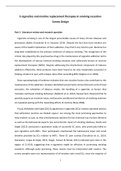Samenvatting
Building Blocks of English 2 - Summary
This summary provides a complete overview of the BB2 course and has all the information you need for the exam. The different sections deal with the different research proposal sections and their goals and structure. Furthermore, examples are given. Overall, all lectures are summarized in this docum...
[Meer zien]













